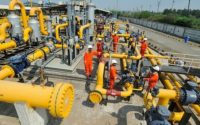Energy Crisis Eroding Europe’s Competitiveness in 2023
Russia’s invasion of Ukraine and subsequent curtailment of gas flows to Europe, and the onset of winters are pushing the international natural gas prices to new highs. Europe’s energy crisis is repeatedly intensifying, triggering a global economic crisis. Major leaks in Nord Stream 1 and 2 natural gas pipelines, considered to be the “aorta” for Europe’s energy supply, has further exacerbated the natural gas crisis and shortages amidst the growing need for electricity during winters. Accounting for 11% of the world’s economy oil and 15% of its gas, Russia is the world’s second-largest producer of oil and gas, and the country holds the potential for big supply shock.
Most of the countries in Central and Eastern Europe are heavily dependent on natural gas supplies from Russia. Revenue from gas exports account for around 2% of Russia’s GDP. On the demand side, reduced access to gas supplies are continuously adding to the energy prices and fuel bills for consumers, pushing the already-high inflation. On the supply side, gas quotas are being imposed on different industry as well as households. As natural gas prices and electricity costs are soaring, businesses are struggling to stay competitive. Many European industries are losing global market shares and shutting down production, risking permanent damage to Europe’s competitiveness. While lower energy usage is helping the Europe weather, the crisis sparked by Russia’s war, the industrial base may end up severely weakened if high energy costs persist. Energy-intensive industries, such as aluminium, fertilizers, and chemicals are already at a risk of companies shifting to locations where shale gas prices are relatively cheaper. In United States, the energy prices are relatively a fifth of what companies pay in Europe.

Moreover, high energy prices could lead to higher debt burdens, business failures, and delay the initiatives to achieve carbon neutrality via green transition. As per the International Energy Agency, the industrial gas demand has fallen by 25% in the third quarter from 2021 due to widespread shutdown of factories and reduction in industrial activity. One in four businesses in the chemicals sector and 16% of the automotive industry are forced to cut production.
Europe’s push to mitigate its reliance on Russian natural gas is increasing demand for liquified natural gas (LNG) through floating terminals in Germany and the Netherlands. Besides, EU also increased production for months to secure energy supplies and prepare for winter. Without Russian gas, the EU would require more natural gas over the next 12 months. Hence, in 2023, the energy market dynamics are likely to remain the same. The energy prices are likely to remain elevated and the economic growth is expected to suffer. Currently, many companies are still shielded by long-term contracts supplying them with gas at prices well below market rates, but those businesses could become vulnerable when the contracts roll off.
Impact of Energy Crunch in Europe on Chemical Industries
The chemical industry is the fourth largest manufacturing industry in EU, responsible for 50.8 million metric tons of oil consumption. The energy crisis has reached an unsustainable level for the European chemical industries, leading to more imports than exports, in terms of volume and value. The chemical industry is the largest European industrial consumer of natural gas, accounting for 15% of the total energy supplies. The production of various energy-intensive chemicals such as ammonia, caprolactam, methanol, melamine, etc. have been cut down by nearly 50%. The market for caustic soda that require power consumption of 2,300-2,450 kWh/tonne (translating to a variable cost of Euro 1,000-1,100/tonne) remains in tight supply. The energy crisis is also making a dent in the competitiveness of the chemical industry as the industry players have to compete on the global market from region with more favourable energy prices. Europe constitutes 20% of global ammonia production and the shutdown of the ammonia capacity could keep the ammonia prices elevated, which could affect the global agrochemical and fertilizer makers.
Some chemical producers in Germany are making detailed plans for rationing where the chemicals and pharmaceuticals industry utilize around 140 TWh per year, equivalent to 15% of Germany’s gas consumption. The chemical giant, BASF’s Ludwigshafen site is the world’s largest integrated chemical complex that accounts for 4% of total German natural gas demand. The company might shut down the site if the gas supply collapses below 50% for a sustained period. BASF utilizes more than 60% of the natural gas it purchases to generate energy and 40% as a raw material to produce basic chemicals. Shutting down of petrochemical sites will affect the availability of raw materials that are important in the value chain such as automotives, construction and electronics. Besides, the unavailability could further dampen economic activity, putting more downward pressure on GDP growth.
Some companies are turning to fossil fuels to meet the heat needs for production. Car manufacturer Volkswagen will be running power plants in Wolfsburg with coal for the next two winters instead of switching to gas, planned as a part of decarbonization effort. Even for the lower temperature industrial processes, there are not many alternatives to keep up with the energy demand. The old nuclear reactors in France are unable to meet demand due to maintenance issues and protracted shutdowns while the summer’s drought has depleted hydropower power generation capacity.
How Europe Plans to Cope Up with the Energy Crunch?
The continent is currently experiencing a short period of cold yet calm weather, which has helped to avoid the energy crisis, but the wind power output has dropped down significantly. The United Kingdom gets quarter of its electricity from offshore and onshore turbines. The power dent created by low wind power supply is being fulfilled by the gas-fired power plants, currently generating 57% of the country’s electricity. Although the Europe’s gas supply looks fairy comfortable for the winter, but the continent is planning to make a shift to liquified natural gas as a vital replacement for lost Russian imports.
European buyers of LNG may have to commit to purchases for 15 years if they want lock in supplies from proposed US export facilities as North America has plenty of gas and can provide it at a reasonable rate. However, replacing two thirds of Russian gas imports would require additional 50 billion cubic meters of LNG, equivalent to 50% of US exports in 2021. Accelerating the pace of energy transition and current high gas prices could significantly lower demand in the long term. In the medium term, much work needs to be done to slash down the prices, deliver the transition to renewable and build Europe’s energy security.



